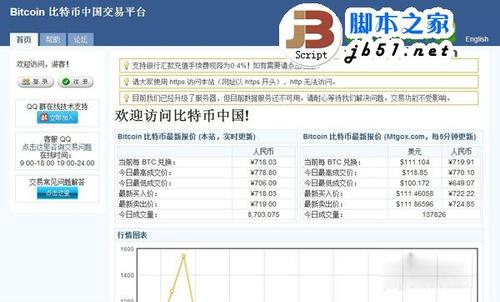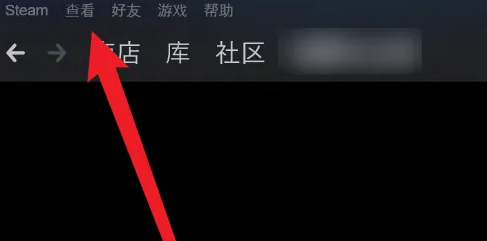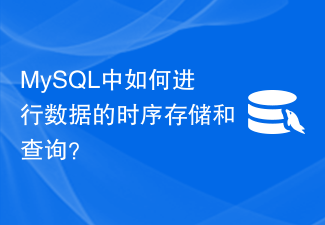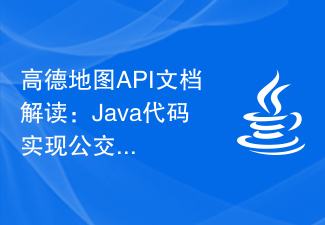 Backend Development
Backend Development PHP Tutorial
PHP Tutorial Steps to implement data caching and query using CakePHP framework
Steps to implement data caching and query using CakePHP frameworkSteps to implement data caching and query using CakePHP framework
With the continuous development of Internet technology, data processing and query have become important links in application development. To improve application performance and responsiveness, data caching is a common solution. When using the CakePHP framework for application development, you can implement data caching and querying through some simple steps.
Step 1: Install the CakePHP framework
First, make sure that PHP and Composer have been successfully installed. Then execute the following command on the command line to install the CakePHP framework:
composer create-project --prefer-dist cakephp/app my_app
This command will create a folder named my_app in the current directory and install the latest version of the CakePHP framework.
Step 2: Create a database
Before using data caching and query, you need to create a database first. In the config directory under the my_app folder, you can find a configuration file named app_local_example.php. Make a copy of it and rename it to app_local.php, and modify it according to your own database configuration.
Step 3: Create data table and model
Enter the my_app folder in the console and execute the following command to create a users data table and corresponding model:
bin/cake bake migration CreateUsers name:string email:string password:string created:timestamp bin/cake migrate bin/cake bake model Users
This command will Create a data table named users and generate a model named Users for interacting with the database.
Step 4: Implement data caching
In CakePHP, you can use the Cache class to implement data caching. First, in the config directory under the my_app folder, open the app.php file, find the section named 'Datasources', and modify it to the following:
'Datasources' => [
'default' => [
'className' => CakeDatabaseConnection::class,
'driver' => CakeDatabaseDriverMysql::class,
'persistent' => false,
'host' => 'localhost',
'username' => 'your_username',
'password' => 'your_password',
'database' => 'your_database',
'encoding' => 'utf8mb4',
'timezone' => 'UTC',
'cacheMetadata' => true,
],
],Then, add the following to the model file Users.php Code, set the data cache time to 1 hour:
namespace AppModelTable;
use CakeCacheCache;
use CakeORMTable;
use CakeORMQuery;
class UsersTable extends Table
{
public function initialize(array $config)
{
parent::initialize($config);
$this->addBehavior('Timestamp');
}
public function findUsers()
{
$query = $this->find('all')
->cache(function ($query) {
return 'users';
}, '1hour');
return $query->all();
}
}In the above code, we cache the data through the cache() method, where the first parameter is the cache key name, and the second parameter is cache time.
Step 5: Implement data query
Add the following code in the controller file UsersController.php to implement user data query:
namespace AppController;
use AppControllerAppController;
use CakeORMTableRegistry;
class UsersController extends AppController
{
public function index()
{
$this->loadModel('Users');
$users = $this->Users->findUsers();
$this->set(compact('users'));
}
}In the above code, we use findUsers( ) method to obtain user data and pass the data to the view through the set() method.
Step 6: Display data
Finally, in the view file index.ctp, add the following code to display user data:
foreach ($users as $user) {
echo $user->name;
echo $user->email;
}In the above code, we traverse the user data and output them separately Name and email.
Through the implementation of the above steps, we can implement data caching and query functions in the CakePHP framework. Use the Cache class to cache data, and query and display data through models and controllers. This can greatly improve the performance and responsiveness of your application. I hope that through the introduction of this article, readers can better understand the steps of data caching and querying in the CakePHP framework.
The above is the detailed content of Steps to implement data caching and query using CakePHP framework. For more information, please follow other related articles on the PHP Chinese website!
 如何查证JBL耳机的真假信息Dec 29, 2023 pm 10:54 PM
如何查证JBL耳机的真假信息Dec 29, 2023 pm 10:54 PMjbl耳机是很多听音乐用户的首选,好评如潮,但是对于假货大家还是非常的害怕的,那么jbl耳机怎么查询真伪来避免这个问题呢?下面就看看怎么查询吧。jbl耳机怎么查询真伪:1、首先进入“中国商品信息验证中心”。2、然后输入查询码,即可查看是否正确从而判断是不是真货。3、也可以去通过耳机声音的清晰度来进行分辨。正牌的耳机声音是非常的清晰的,音质也不会出现改变。假牌的耳机声音会有很多的掺杂,音质也是特别的差。4、大家可以将自己的耳机声音开到最大,看看是不是很和谐,真耳机声音都是一样的。但是假耳机的声音开
 买过比特币怎么查询,怎么看自己买没买过比特币Feb 04, 2024 am 08:09 AM
买过比特币怎么查询,怎么看自己买没买过比特币Feb 04, 2024 am 08:09 AM现在怎么买比特币的800字公众号文章随着比特币的价格飙升,越来越多的人开始关注比特币,也有越来越多的人想要投资比特币。但是,投资比特币也是有风险的,所以在投资之前,需要了解相关知识,并做好风险控制。那么现在怎么买比特币呢?首先,为了投资比特币,您需要准备一个比特币钱包。比特币钱包是一种软件,用于存储、发送和接收比特币资金。根据您的需求,有多种类型的比特币钱包可供选择,例如硬件钱包、软件钱包和网络钱包。每种钱包都有其独特的特点,您可以根据自己的需求选择适合自己的。其次,你需要选择一个可靠的比特币交
 steam怎么查询账号idFeb 07, 2024 pm 12:09 PM
steam怎么查询账号idFeb 07, 2024 pm 12:09 PMSteam是一个整合游戏下载平台,玩家可以在该平台上购买正版的游戏,也可以跟其他玩家进行沟通讨论交流。有小伙伴知道steam怎么查询账号id吗,下面小编就给大家详细介绍一下steam查询账号id的方法,有需要的小伙伴可以来看一看。查询方法:1、双击打开软件,点击上方菜单栏中的"查看"。2、然后点击下方选项列表中的"设置"。3、在打开的窗口界面中,点击左侧栏中的"账户"选项,然后找到右侧中的"账户名称"即可查询到账号id。
 PHP如何查询Oracle数据库中的数据Jul 13, 2023 pm 07:34 PM
PHP如何查询Oracle数据库中的数据Jul 13, 2023 pm 07:34 PMPHP如何查询Oracle数据库中的数据随着互联网时代的到来,网站和应用程序的开发越来越普遍。而数据库作为数据存储和管理的关键技术,也成为了开发者们必备的工具之一。其中,Oracle数据库作为一款功能强大、稳定可靠的关系型数据库管理系统,在企业级应用中得到了广泛应用。而在开发网站或应用程序时,如何使用PHP进行Oracle数据库的查询是一个非常重要的问题。在
 PHP表单处理:表单数据查询与筛选Aug 07, 2023 pm 06:17 PM
PHP表单处理:表单数据查询与筛选Aug 07, 2023 pm 06:17 PMPHP表单处理:表单数据查询与筛选引言在Web开发中,表单是一种重要的交互方式,用户可以通过表单向服务器提交数据并进行进一步的处理。本文将介绍如何使用PHP处理表单数据的查询与筛选功能。表单的设计与提交首先,我们需要设计一个包含查询与筛选功能的表单。常见的表单元素包括输入框、下拉列表、单选框、复选框等,根据具体需求进行设计。用户在提交表单时,会将数据以POS
 查询从节点X开始,距离最多为D的子树中的最小权重Aug 25, 2023 am 11:25 AM
查询从节点X开始,距离最多为D的子树中的最小权重Aug 25, 2023 am 11:25 AM在进行计算机编程时,有时需要求出源自特定节点的子树的最小权重,条件是该子树不能包含距离指定节点超过D个单位的节点。这个问题出现在各个领域和应用中,包括图论、基于树的算法和网络优化。子树是较大树结构的子集,指定的节点作为子树的根节点。子树包含根节点的所有后代及其连接边。节点的权重是指分配给该节点的特定值,可以表示其重要性、重要性或其他相关指标。在这个问题中,目标是找到子树中所有节点中的最小权重,同时将子树限制在距离根节点最多D个单位的节点。在下面的文章中,我们将深入研究从子树中挖掘最小权重的复杂性
 MySQL中如何进行数据的时序存储和查询?Jul 30, 2023 pm 03:09 PM
MySQL中如何进行数据的时序存储和查询?Jul 30, 2023 pm 03:09 PMMySQL中如何进行数据的时序存储和查询?在许多应用场景中,对于数据的时序性要求是非常常见的,比如传感器数据的监测、日志记录等。MySQL作为一种常用的关系型数据库,也提供了一些方法来进行时序数据的存储和查询。一种常见的方法是使用时间戳字段来存储数据的时间信息。在MySQL中,可以使用TIMESTAMP或DATETIME类型的字段来存储时间。TIMESTAM
 高德地图API文档解读:Java代码实现公交车在线运行状态查询Jul 29, 2023 pm 10:45 PM
高德地图API文档解读:Java代码实现公交车在线运行状态查询Jul 29, 2023 pm 10:45 PM高德地图API文档解读:Java代码实现公交车在线运行状态查询导语:随着城市的发展,公共交通的重要性越来越凸显出来。人们对公交车的运行状态有着强烈的需求,例如实时到站时间、拥挤程度等信息。高德地图提供了强大的API以满足这方面的需求。本文将解读高德地图API文档,使用Java代码实现公交车在线运行状态查询,并提供代码示例。API概述高德地图API提供了丰富的


Hot AI Tools

Undresser.AI Undress
AI-powered app for creating realistic nude photos

AI Clothes Remover
Online AI tool for removing clothes from photos.

Undress AI Tool
Undress images for free

Clothoff.io
AI clothes remover

AI Hentai Generator
Generate AI Hentai for free.

Hot Article

Hot Tools

WebStorm Mac version
Useful JavaScript development tools

SublimeText3 Linux new version
SublimeText3 Linux latest version

ZendStudio 13.5.1 Mac
Powerful PHP integrated development environment

SublimeText3 Mac version
God-level code editing software (SublimeText3)

SublimeText3 English version
Recommended: Win version, supports code prompts!





